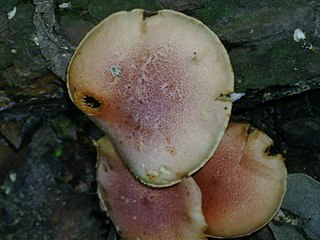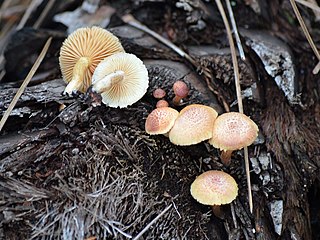
Gymnopilus junonius is a type of mushroom-forming fungus in the family Hymenogastraceae. Commonly known as the spectacular rustgill, this large orange mushroom is typically found growing on tree stumps, logs, or tree bases. Some subspecies of this mushroom contain the neurotoxic oligoisoprenoid gymnopilin.

Gymnopilus is a genus of gilled mushrooms within the fungal family Hymenogastraceae containing over 200 rusty-orange spored mushroom species formerly divided among Pholiota and the defunct genus Flammula. The fruit body is typically reddish brown to rusty orange to yellow, medium to large, often with a well-developed veil. Most members of Gymnopilus grow on wood but at times may appear terrestrial if the wood is buried or decomposed. Members of Pholiota and Cortinarius are easy to confuse with Gymnopilus. Pholiota can be distinguished by its viscid cap and duller spores, and Cortinarius grows on the ground. Beginners can confuse Gymnopilus with Galerina, which contains deadly poisonous species.

Gymnopilus luteofolius, known as the yellow-gilled gymnopilus, is a large and widely distributed mushroom that grows in dense clusters on dead hardwoods and conifers. It grows in late July to November in the east and in the winter on the west coast of North America. It has a rusty orange spore print and a bitter taste.

Gymnopilus aeruginosus, also known as the magic blue gym, is a mushroom-forming fungus that grows in clusters on dead wood and wood chip mulch. It is widely distributed and common in the Pacific Northwest. It has a rusty orange spore print and a bitter taste and contains the psychedelic chemical psilocybin. It was given its current name by mycologist Rolf Singer in 1951.

Gymnopilus purpuratus is a species of agaric fungus in the family Hymenogastraceae. It grows in clusters on dead wood, tree stumps and wood chip mulch. It is widely distributed and has been recorded in Argentina, Australia, Chile, New Zealand, the UK and Germany. It has a broadly convex cap covered in small dry reddish-brown scales, a stout yellow stem beneath reddish brown, wine-red to purple vertical fibres, and a thick rusty orange spore print.

Gymnopilus sapineus, commonly known as the scaly rustgill or common and boring gymnopilus, is a small and widely distributed mushroom which grows in dense clusters on dead conifer wood. It has a rusty orange spore print and a bitter taste. This species does not stain blue and lacks the hallucinogen psilocybin.

Gymnopilus validipes is a mushroom in the family Hymenogastraceae. It is widely distributed in North America and Europe.
Gymnopilus cyanopalmicola is a species of mushroom-forming fungus in the family Hymenogastraceae. Found in tropical Mexico, it was described as new to science by Mexican mycologist Laura Guzmán Dávalos in 2006. The flesh of this mushroom turns blue when bruised, hence the specific epithet.

Gymnopilus dilepis is a species of mushroom in the family Hymenogastraceae. This species is found in India, Malaysia, and North America. It was given its current name by mycologist Rolf Singer in 1951. It contains psilocybin and related hallucinogenic substances.
Gymnopilus hispidellus is a species of mushroom in the family Hymenogastraceae.
Gymnopilus medius is a species of mushroom in the family Hymenogastraceae.

Gymnopilus subpurpuratus is a species of mushroom in the family Hymenogastraceae. The type specimen was found in Jalisco, Mexico, growing on rotting pine wood in a garden. The fungus was described as new to science in 1991 by Gastón Guzmán and his daughter Laura Guzmán Dávalos.
Gymnopilus suberis is a species of mushroom in the family Hymenogastraceae. It was given its current name by mycologist Rolf Singer in 1951.
Gymnopilus rugulosus is a species of mushroom in the family Hymenogastraceae.

Gymnopilus lepidotus is a species of mushroom-forming fungus in the family Hymenogastraceae.
Gymnopilus nevadensis is a species of mushroom in the family Hymenogastraceae. The fungus was described as new to science in 1991 by Gastón Guzmán and his daughter Laura Guzmán Dávalos. The type collection was found in Jalisco, Mexico, where it was fruiting in a cluster on a dead branch in a pine and oak woodland.

Gymnopilus palmicola is a species of mushroom in the family Hymenogastraceae.

Gymnopilus peliolepis is a species of mushroom in the family Hymenogastraceae. It was given its current name by mycologist Rolf Singer in 1951.

Gymnopilus maritimus is a fungus species of the family Hymenogastraceae first collected in northern Sardinia, Italy, in 2006. The species produces moderately sized, sturdy mushrooms of a reddish-orange colour. The cap, which can measure up to 70 millimetres (3 in) across, is covered in orange fibrils, and sometimes has small scales. The yellowish stem measures up to 110 mm (4 in) in length by 8 mm (0.3 in) in width, and sometimes shows remnants of the partial veil. The mushrooms have thick gills of a variable colour, ranging from yellow to rust but staining darker, and the yellow flesh has a mild taste. The mushrooms leave a rusty-brown spore print, while the spores themselves measure from 7.5–11.5 micrometres (0.00030–0.00045 in) in length. The species is most similar in appearance to G. arenophilus and G. fulgens, but can be differentiated from both morphologically. Despite the similarities, it is not closely related to either, suggesting convergent evolution. Instead, within the genus Gymnopilus, it is most closely related to the spectabilis–imperialis clade. However, it is not particularly similar to any of its closest relatives.












